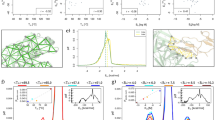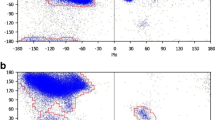Abstract
We report a simple algorithm to scan interfaces in protein–protein complexes for identifying binding ‘hot spots’. The change in side-chain solvent accessible area (ΔASA) of interface residues has been related to change in binding energy due to mutating interface residues to Ala (ΔΔG X → ALA) based on two criteria—hydrogen bonding across the interface and location in the interface core—both of which are major determinants in specific, high-affinity binding. These relationships are used to predict the energetic contribution of individual interface residues. The predictions are tested against 462 experimental X → ALA mutations from 28 interfaces with an average unsigned error of 1.04 kcal/mol. More than 80% of interface hot spots (with experimental ΔΔG ≥ 2 kcal/mol) could be identified as being energetically important. From the experimental values, Asp, Lys, Tyr and Trp are found to contribute most of the binding energy, burying >45 Å2 on average. The method described here would be useful to understand and interfere with protein interactions by assessing the energetic importance of individual interface residues.





Similar content being viewed by others
References
Jones S, Thornton JM (1996) Principles of protein–protein interactions. Proc Natl Acad Sci USA 93:13–20. doi:10.1073/pnas.93.1.13
Lo Conte L, Chothia C, Janin J (1999) The atomic structure of protein–protein recognition sites. J Mol Biol 285:2177–2198. doi:10.1006/jmbi.1998.2439
Chakrabarti P, Janin J (2002) Dissecting protein–protein recognition sites. Proteins 47:334–343. doi:10.1002/prot.10085
Neuvirth H, Raz R, Schreiber G (2004) ProMate: a structure based prediction program to identify the location of protein–protein binding sites. J Mol Biol 338:181–199. doi:10.1016/j.jmb.2004.02.040
Clackson T, Wells JA (1995) A hot spot of binding energy in a hormone–receptor interface. Science 267:383–386. doi:10.1126/science.7529940
Bogan AA, Thorn KS (1998) Anatomy of hot spots in protein interfaces. J Mol Biol 280:1–9. doi:10.1006/jmbi.1998.1843
DeLano WL, Ultsch MH, de Vos AM, Wells JA (2000) Convergent solutions to binding at a protein–protein interface. Science 287:1279–1283. doi:10.1126/science.287.5456.1279
DeLano WL (2002) Unraveling hot spots in binding interfaces: progress and challenges. Curr Opin Struct Biol 12:14–20. doi:10.1016/S0959-440X(02)00283-X
Eisenberg D, Marcotte EM, Xenarios I, Yeates TO (2000) Protein function in the post-genomic era. Nature 405:823–826. doi:10.1038/35015694
Keskin O, Ma B, Nussinov R (2005) Hot regions in protein–protein interactions: the organization and contribution of structurally conserved hot spots residues. J Mol Biol 345:1281–1294. doi:10.1016/j.jmb.2004.10.077
Massova I, Kollman PA (1999) Computational alanine scanning to probe protein–protein interactions: a novel approach to evaluate binding free energies. J Am Chem Soc 121:8133–8143. doi:10.1021/ja990935j
Guerois R, Nielsen JE, Serrano L (2002) Predicting changes in the stability of proteins and protein complexes: a study of more than 1000 mutations. J Mol Biol 320:369–387. doi:10.1016/S0022-2836(02)00442-4
Huo S, Massova I, Kollman PA (2002) Computational alanine scanning of the 1:1 human growth hormone–receptor complex. J Comput Chem 23:15–27. doi:10.1002/jcc.1153
Kortemme T, Baker D (2002) A simple physical model for binding energy hot spots in protein–protein complexes. Proc Natl Acad Sci USA 99:14116–14121. doi:10.1073/pnas.202485799
Kortemme T, Kim DE, Baker D (2004) Computational alanine scanning of protein–protein interfaces. Sci STKE 219:pl2
Pokala N, Handel TM (2005) Energy functions for protein design: adjustment with protein–protein complex affinities, models for the unfolded state, and negative design of solubility and specificity. J Mol Biol 347:203–227. doi:10.1016/j.jmb.2004.12.019
Almlöf M, Aqvist J, Smalås AO, Brandsdal BO (2006) Probing the effect of point mutations at protein–protein interfaces with free energy calculations. Biophys J 90:433–442. doi:10.1529/biophysj.105.073239
Moreira IS, Fernandes PA, Ramos MJ (2006) Unraveling the importance of protein–protein interaction: application of a computational alanine-scanning mutagenesis to the study of the IgG1 streptococcal protein G (C2 fragment) complex. J Phys Chem B 110:10962–10969. doi:10.1021/jp054760d
Ofran Y, Rost B (2007) Protein–protein interaction hotspots carved into sequences. PLoS Comput Biol 3:e119. doi:10.1371/journal.pcbi.0030119
Moreira IS, Fernandes PA, Ramos MJ (2007) Computational alanine scanning mutagenesis—an improved methodological approach. J Comput Chem 28:644–654. doi:10.1002/jcc.20566
Guney E, Tuncbag N, Keskin O, Gursoy A (2008) HotSprint: database of computational hot spots in protein interfaces. Nucleic Acids Res 36:D662–D666. doi:10.1093/nar/gkm813
Kauzmann W (1959) Some factors in the interpretation of protein denaturation. Adv Protein Chem 14:1–63. doi:10.1016/S0065-3233(08)60608-7
Chothia C, Janin J (1975) Principles of protein–protein recognition. Nature 256:705–708. doi:10.1038/256705a0
Janin J, Chothia C (1990) The structure of protein–protein recognition sites. J Biol Chem 265:16027–16030
Young L, Jernigan RL, Covell DG (1994) A role for surface hydrophobicity in protein–protein recognition. Protein Sci 3:717–729
Tsai C-J, Lin SL, Wolfson HJ, Nussinov R (1997) Studies of protein–protein interfaces: a statistical analysis of the hydrophobic effect. Protein Sci 6:53–64
Li Y, Huang Y, Swaminathan CP, Smith-Gill SJ, Mariuzza RA (2005) Magnitude of the hydrophobic effect at central versus peripheral sites in protein–protein interfaces. Structure 13:297–307. doi:10.1016/j.str.2004.12.012
Xu D, Lin SL, Nussinov R (1997) Protein binding versus protein folding: the role of hydrophilic bridges in protein associations. J Mol Biol 265:68–84. doi:10.1006/jmbi.1996.0712
Fernández A, Scheraga HA (2003) Insufficiently dehydrated hydrogen bonds as determinants of protein interactions. Proc Natl Acad Sci USA 100:113–118. doi:10.1073/pnas.0136888100
Hu Z, Ma B, Wolfson H, Nussinov R (2000) Conservation of polar residues as hot spots at protein interfaces. Proteins 39:331–342. doi:10.1002/(SICI)1097-0134(20000601)39:4<331::AID-PROT60>3.0.CO;2-A
Guharoy M, Chakrabarti P (2005) Conservation and relative importance of residues across protein–protein interfaces. Proc Natl Acad Sci USA 102:15447–15452. doi:10.1073/pnas.0505425102
Chothia C (1974) Hydrophobic bonding and accessible surface area in protein. Nature 248:338–339. doi:10.1038/248338a0
Eisenhaber F (1996) Hydrophobic regions on protein surfaces. Derivation of the solvation energy from their area distribution in crystallographic protein structures. Protein Sci 5:1676–1686. doi:10.1002/pro.5560050821
Thorn KS, Bogan AA (2001) ASEdb: a database of alanine mutations and their effects on the free energy of binding in protein interactions. Bioinformatics 17:284–285. doi:10.1093/bioinformatics/17.3.284
ShajiKumar MD, Gromiha MM (2006) PINT: protein–protein interactions thermodynamic database. Nucleic Acids Res 34:D195–D198. doi:10.1093/nar/gkj017
Berman HM, Westbrook J, Feng Z, Gilliland G, Bhat TN, Weissig H, Shindyalov IN, Bourne PE (2000) The protein data bank. Nucleic Acids Res 28:235–242. doi:10.1093/nar/28.1.235
Saha RP, Bahadur R, Pal A, Mandal S, Chakrabarti P (2006) ProFace: a server for the analysis of the physicochemical features of protein–protein interfaces. BMC Struct Biol 6:11. doi:10.1186/1472-6807-6-11
McDonald IK, Thornton JM (1994) Satisfying hydrogen bonding potential in proteins. J Mol Biol 238:777–793. doi:10.1006/jmbi.1994.1334
Guharoy M, Chakrabarti P (2007) Secondary structure based analysis and classification of biological interfaces: identification of binding motifs in protein–protein interactions. Bioinformatics 23:1909–1918. doi:10.1093/bioinformatics/btm274
Chothia C (1976) The nature of the accessible and buried surfaces in proteins. J Mol Biol 105:1–12. doi:10.1016/0022-2836(76)90191-1
Rodier F, Bahadur RP, Chakrabarti P, Janin J (2005) Hydration of protein–protein interfaces. Proteins 60:36–45. doi:10.1002/prot.20478
Clackson T, Ultsch MH, Wells JA, de Vos AM (1998) Structural and functional analysis of the 1:1 growth hormone:receptor complex reveals the molecular basis for receptor affinity. J Mol Biol 277:1111–1128. doi:10.1006/jmbi.1998.1669
Albeck S, Unger R, Schreiber G (2000) Evaluation of direct and cooperative contribution towards the strength of buried hydrogen bonds and salt bridges. J Mol Biol 298:503–520. doi:10.1006/jmbi.2000.3656
Schreiber G, Shaul Y, Gottschalk KE (2006) Electrostatic design of protein–protein association rates. Methods Mol Biol 340:235–249
Ogmen U, Keskin O, Aytuna AS, Nussinov R, Gursoy A (2005) PRISM: protein interactions by structural matching. Nucleic Acids Res 33:W331–W336. doi:10.1093/nar/gki585
Halperin I, Wolfson H, Nussinov R (2004) Protein–protein interactions: coupling of structurally conserved residues and of hot spots across interfaces. Implications for docking. Structure 12:1027–1038. doi:10.1016/j.str.2004.04.009
Acknowledgments
We are grateful to Prof. Joël Janin for his comments on the manuscript. MG is a recipient of a senior research fellowship from CSIR and PC is a JC Bose National Fellow. The funding was provided by DBT, India.
Author information
Authors and Affiliations
Corresponding author
Electronic supplementary material
Below is the link to the electronic supplementary material.
Rights and permissions
About this article
Cite this article
Guharoy, M., Chakrabarti, P. Empirical estimation of the energetic contribution of individual interface residues in structures of protein–protein complexes. J Comput Aided Mol Des 23, 645–654 (2009). https://doi.org/10.1007/s10822-009-9282-3
Received:
Accepted:
Published:
Issue Date:
DOI: https://doi.org/10.1007/s10822-009-9282-3




